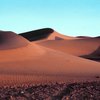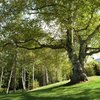Deserts and grasslands are biomes known for their low precipitation and lack of trees. They are found on nearly every continent and within close proximity of each other. The lack of water and other key resources makes life in these climates difficult and challenging, but not impossible. Nevertheless, both deserts and grasslands are thought of by residents of other climates as being unique and exotic, and both are home to rare wildlife.
High Summer Temperatures
Deserts and grasslands have very high summer temperatures that are not found in other climate zones, except tropical rain forests. The deserts of Libya as well as Death Valley, California have exceeded 130 degrees and are the hottest places on earth. Grasslands in the central United States and sub-Saharan Africa exceed 100 degrees in the summer. The same is true for the steppes of Kazakhstan and Central Asia. Though cool and even cold temperatures visit grasslands and deserts during the winter, they are the most arid places on earth, especially during the summer.
Low Rainfall
Deserts and grasslands both receive low amounts of rainfall compared to other biomes. It is rare for rainfall in grasslands to exceed 35 inches in a year, and some grasslands receive as little as 6 inches of rain per year. Deserts average less than 10 inches of rain per year, with parts of the Atacama Desert in Chile averaging one millimeter of rain in a single year. By contrast, humid subtropical climates average roughly 48 inches of rain per year. Though lack of rain persists persists for months in deserts and grasslands, they are both susceptible to flooding when rain finally arrives.
Scarcity of Trees
Both deserts and grasslands contain few trees, but are not entirely devoid of them. A typical desert contains vast stretches of sand and mountains, although some trees thrive in that kind of environment. Examples include the Afghan Pine and the Chilean Mesquite, which can grow up to 40 feet tall. Trees are absent from temperate grasslands in South America and Asia, though baobab trees are found sporadically in the savannas of Africa.
Geographical Proximity
In addition to their dry climate with low rainfall and warm temperatures, deserts and grasslands are often found in close proximity to each other. The grasslands of the Great Plains in the United States border the deserts of the large Great Basin of the Western United States. Furthermore, Dry savanna grasslands in Africa border the Sahara Desert, and Mongolian steppes border the Gobi Desert.
References
Photo Credits
- Jupiterimages/Brand X Pictures/Getty Images




